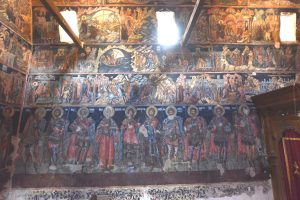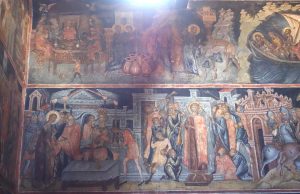 The monastery is situated in the western part of the islet of Ioannina. It was founded in the end of the 13th century by Michael Philanthropinon and over the years it has been maintained and renewed by some eminent members of the same family. In the 16th century, the new ktetor of the monastery is its hegumen Josaphat Philanthropinon.
The monastery is situated in the western part of the islet of Ioannina. It was founded in the end of the 13th century by Michael Philanthropinon and over the years it has been maintained and renewed by some eminent members of the same family. In the 16th century, the new ktetor of the monastery is its hegumen Josaphat Philanthropinon.
The monastery church in its present-day form was constructed in several stages in the16th century. It consists of a naos (the altar has one apsis), inner narthex and three exonarthices encircling it from the south, west and north. All premises are overarched.
According to the ktetor’s inscriptions the paintings in the naos and inner narthex were made in 1542, and those in the three exonarthices were made in 1560.
The mural ensemble is impressive for its iconographic diversity.
A big part of the program in the naos is dedicated to Christ’s life on earth emphasizing the episodes representing the Passion, the Miracles and the Acts of Jesus. Scenes from the apocryphal narrative of Virgin Mary’s childhood have also made their way here as the theme of the Holy Mother of God is continued in the program of the narthex (Dormition of the Virgin, “The prophets from on high”, the Akathistos Hymn). In the narthex, there is also a vita cycle of St. Nicolas, the patron saint of the church as well as the composition depicting some prominent, already deceased members of the Philanthropinon family led by the monastery’s ktetor Josaphat. A menologion begins in the narthex, which is restricted to the months from September to December in this part of the church. In the western exonarthex there are a composition visualizing the psalms “Praise the Lord”, scenes depicting the Parables of Jesus and images of full-length monks.
 The menologion for the months from December to August is continued in the northern exonarthex. Here there is a representation of the story of human ancestors, Adam and Eve, their offspring as well as many more Old Testament personalities such as Noah, Joseph the All-Comely, Jacob, Moses. In the southern exonarthex there is a program dedicated to other Old Testament personalities such as Joshua, Daniel and Elias. The images of Ancient Greek philosophers are also located there. The southern exonarthex is the part of the church through which one enters the remaining parts of the church and for this reason the composition of the Last Judgment is also located here.
The menologion for the months from December to August is continued in the northern exonarthex. Here there is a representation of the story of human ancestors, Adam and Eve, their offspring as well as many more Old Testament personalities such as Noah, Joseph the All-Comely, Jacob, Moses. In the southern exonarthex there is a program dedicated to other Old Testament personalities such as Joshua, Daniel and Elias. The images of Ancient Greek philosophers are also located there. The southern exonarthex is the part of the church through which one enters the remaining parts of the church and for this reason the composition of the Last Judgment is also located here.
The frescoes are preserved almost entirely and are in a very good state.
Maria Kolusheva
Main References
Αχειμάστου-Ποταμιάνου, Μ. Η μονή των Φιλανθρωπηνών και η πρώτη φάση της μεταβυζαντινής ζωγραφικής. Αθήναι, 1983.
Αχειμάστου-Ποταμιάνου, Μ. Οι τοιχογραφίες της μονής των Φιλανθρωπηνών στο νησί των Ιωαννίνων. Αθήνα, 2004.
